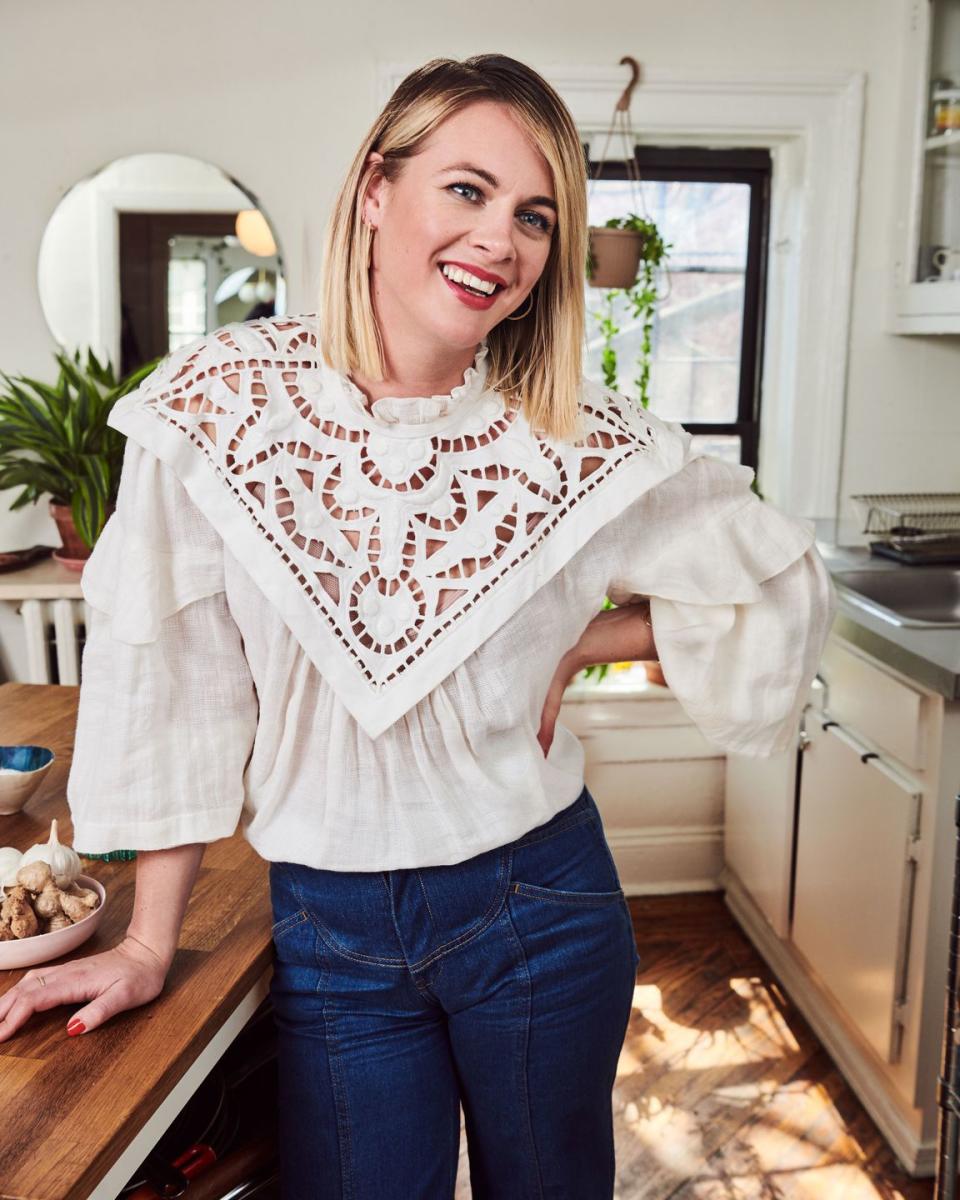Making a Soon-to-Be Viral Salad with Alison Roman

Alison Roman is taking her aggression out on the aioli. In her airy apartment kitchen on the top floor of a Brooklyn brownstone, she’s whisking egg yolks and oil and garlic until they’re the color and texture of fresh cream while chatting about how it sucks, at times, to be best known as a creator of viral recipes.
Her most recent hit was a chickpea and coconut milk stew she created for the New York Times that became known on social media simply as “#thestew,” prompting a Slate article headlined “Is #TheStew Actually That Good?” Roman knows that she should ignore this kind of trollery. She knows it’s not a good use of her time and energy to engage with her detractors, and she understands that this kind of criticism is actually a good sign, because how often does a recipe get so well known that people get mad online about it?
Still, she whisks a bit harder-but with expert control-when I bring up the Slate piece. “I was just like, ‘What? Do you know how cooking works? Have you ever cooked a thing?’ I was so incensed.” She pauses, considering her words, or maybe calibrating the precise texture of the sauce. “I’ve been cooking my whole life. This is all I’ve ever done, and I care so much about the recipes that I make and the stuff that I put out in the world, that to have somebody assume that I didn’t think it through lit me on fire.”

Roman’s fiery nature has taken her far. At 33, she is the author of Dining In, a best-selling collection of recipes she calls “highly cookable”; has a regular column in the New York Times; and boasts an Instagram account with nearly 200,000 followers. Dining In has the minimalist chic of a niche lifestyle magazine like CherryBombe or Kinfolk: Supersaturated food photographs contrast with stark chunks of blinding-white negative space. Everything is served in white, cream, or millennial-pink ceramic vessels, scattered with handfuls of herbs. The book is ubiquitous in the kitchens of the kind of stylish young women who, like Roman, might Instagram their own manicured hands as they fan out a lettuce head or grasp a chicken leg. There are around 100,000 copies of it in print.
The salad we’re about to eat is, perhaps unsurprisingly, very Alison Roman and a good example of what she means by “highly cookable.” It incorporates flavors of a restaurant dish that many people are familiar with, but with a twist that makes it both more delicious to eat and more interesting to cook. Roman’s introductions to her recipes seduce you by making both the food and the process seem enticing: You probably have some of the ingredients on hand, you realize, and anyway, it doesn’t seem that hard. “I’ll be more articulate when I sell it in the column,” she says of the shrimp salad, before explaining that it’s her take on classic Shrimp Louis, except that she hates creamy dressing and ketchup-two of Shrimp Louis’s seemingly nonnegotiable ingredients. Her solution is to deconstruct the dish’s flavors, omitting the elements she doesn’t love and leaving only the ones she does. She tops a platter of crisp lettuces and microgreens with shaved radishes, poached shrimp, jammy eggs, green beans, and an assertive shallot vinaigrette. She serves the punchy, creamy aioli on the side for dipping, an extra step that elevates the dish but doesn’t add much time or effort. The result is a salad that has exactly as much creamy dressing as each individual diner wants on each individual bite. “I don’t want to serve you, because I know every salad component is a really personal thing,” she says as she puts the platter on the table.
To casual observers, Roman’s rise probably seems sudden and effortless. An uncharitable or envious observer might even be tempted to chalk it up to Roman’s considerable cuteness. It’s true that she has a mane of thick yellow-blond hair and very long, subtly tattooed limbs, and that these assets feature semiprominently in the cookbook. But they don’t overshadow the food; her looks and personality are simply another part of the aesthetic. Even her omnipresent orangey-red manicure carries meaning.
Samin Nosrat, the author, chef, and star of Netflix’s Salt, Fat, Acid, Heat, loves that Roman’s nails often appear in photos of her food. “To me, the nail polish thing is deeply subversive,” she tells me. “I don’t think I had a mani until I was 32 years old.” She’s never met Roman, but admires her work a great deal. “I started cooking when I was 19, and cooks in restaurants don’t wear nail polish because it will chip and get in your food. I spent all this time as a young cook trying to gain some measure of respect in this field. That meant fitting in and doing whatever it took to be accepted and taken seriously among mostly men, but also women, who had been sort of...pounded into submission by an industry formed by men.” To Nosrat, Roman’s nails say, “I dare you not to take me seriously. Look! I can be a serious cook who came up in this very male-dominated field, and I can be my whole feminine self.” (For the record, the manicure is gel; Roman doesn’t own a dishwasher. “A regular manicure lasts less than a day on me,” she says.)
{% verbatim %}
A post shared by Alison Roman (@alisoneroman) on May 22, 2019 at 8:22am PDT
{% endverbatim %}
Instagram is a huge part of Roman’s success; it is the dominant mode of food-culture dissemination these days, and she has always been a natural. Her own feed is a careful, but never careful-seeming, seamless blend of personal and professional-which often merge for her anyway. If she’s cooking for her friends, she’s recipe testing. If she’s traveling, she’s doing research. At the parties she features on her grid, the food looks casual but also perfect. A shot of a platter overflowing with sliced vegetables also has an unrelated wine bottle and opener and cutting board in the frame, making it clear that this is just life, not a photo shoot, not quite. When you cook her recipes, you can imagine that your life is that effortlessly photogenic, too.
But while there are plenty of people who are great at Instagram-influencers who shoot their plates at restaurants and chefs who design those plates for maximum impact-what sets Roman apart is that the food looks both delicious and achievable. The vibe is less showoffy than genuinely shareable. “She is very aesthetically driven, and she’s very good at making beautiful food,” Nosrat says. “But also, she never makes it too hard to make yourself. And so it’s this thing where you get to feel a victory when you make something that she makes.”
Times deputy food editor Emily Weinstein, who was instrumental in bringing Roman’s column to the paper, notes that Roman often styles her own photo shoots-unusual for a writer. “She thinks so visually that when she’s pitching ideas, you already know that she has it in her head exactly what it is going to look like, and how enticing it will look to people. And how to entice them to eat it.”
Roman was born and raised in Los Angeles, where she dropped out of college to work at a restaurant, Sona, at 19. After two years there and three at Quince in San Francisco, she decided to move to New York to try to find some other kind of food job. She landed at David Chang’s then-ascendant Momofuku empire, at the experimental bakery Milk Bar, working with founder and chef Christina Tosi to shape its now-renowned signature high/low deliciousness. “Alison was one of the very first ‘milk maids’-the insanely dedicated group of young women with me from nearly the beginning, who helped make Milk Bar what it is today,” says Tosi, who oversees Milk Bar’s eight New York locations and its outposts in Boston, Los Angeles, Toronto, Washington, DC, and Las Vegas. You can still see traces of the Momofuku signature flavors in Roman’s food; she loves to jack up an ordinary American dish by adding something slightly out of the ordinary, like yuzu kosho, anchovies, or preserved lemon. In search of a respite from the high-stress restaurant lifestyle, she next took a job at Bon Appétit, where she learned to develop recipes and began to hone the Alison Roman aesthetic.

She adores high contrasts and extremes: wincingly bitter dandelion or broccoli rabe, bloody-rare meat, chicken skin so crispy it shatters like bacon under your teeth. And she hates the idea that her food might be misrepresented. At a few of her book events, people served Alison Roman recipes. “It was like my personal hell. Not that the food was bad. It was just, like, I had no control over it. Even if you as the diner would never know if it was better or worse than what I would have done, I knew and it drove me insane.”
That’s not to say that she’s not willing to make sacrifices in the service of cookability-they just have to be the right sacrifices, the ones she has thought through in her own kitchen. She knows, for example, that #thestew’s crispy chickpea topping is more easily achieved by roasting some of the chickpeas separately in the oven, but she refused to require another dirtied dish (and she knows the recipe wouldn’t have been as popular if she’d added that step). She also understands that she sets the bar higher for herself than some of her peers do; there are cookbook writers who hire assistants to develop and test recipes for them, and it’s been suggested to Roman that she’s reached the stage in her career where she should start outsourcing. She imagines that way of working with theatrical disdain: “So I tell you what to do, and you do it,and I taste it and say, ‘Okay, let’s add another tablespoon of lemon juice or something. Let’s cook it five to six minutes longer.’ ” She pauses, looking around her tiny kitchen as though imagining where this theoretical sous chef would even fit. “I’m like, What the fuck?! I could never do that. I will always struggle as a result. I will always be behind, and I will always miss my deadlines and always be stressed out because of my inability to let someone else do the work.”
When we’re done smearing shrimp with aioli, Roman and I head out to do some grocery shopping for the next recipe she’s testing. Her neighborhood in picturesque Boerum Hill is rich in high-toned specialty shops and Middle Eastern groceries, and while she avails herself of these, she likes to shop at the most ordinary stores possible when testing recipes. She wants to knowhow the food will taste when made with the ingredients people are most likely to actually use.
On the walk over, we talk about the book she’s reading (the latest Sally Rooney), and I ask whether she’s read her friend Stephanie Danler’s book Sweetbitter, a sexy, decadent account of being young and working in a restaurant. I’m surprised, but also not, when she says she hasn’t gotten around to it yet. She mentions not wanting to relive something she’s experienced firsthand and also that the book is written from a “front-of-house perspective.” What she says next actually does shock me. “I don’t really consume any food media. I don’t read magazines; I don’t read cookbooks. The exception, of course, being Instagram, but since I muted a ton of people that are, like, food people, I’ve become so much happier.” As a cookbook nerd, I’m stunned-and kind of appalled-that Roman doesn’t study the medium, but I also understand where she’s coming from. If you don’t know that everyone and their mother is post-ing a recipe for keto meatballs this week, you won’t be tempted to weigh in with your own superior version.
At the grocery store, the employees all seem to recognize Roman, who cases the produce aisle and skims the perimeter of the store with practiced ease. It’s early March, and she’s developing recipes that will be in the Times around the Fourth of July, debating the merits of a salad story. People “just don’t care” about another grilling recipe, she figures. A besotted worker behind the butcher counter engages in a deep chat with her about some different cuts of lamb, and when she picks one, she tells him, “Thank you-I’ll think of you when I cook it,” surely making his day.
We head for the checkout. She’s filled her basket with meat and vegetables and tofu, ingredients to make meals to entertain her own guests and the readers of the New York Times. Her next book, like Dining In, will focus on meals to impress and delight dates and friends. Being single, right now, is working for Roman. It works for her brand. Her recipes are well suited to a life phase many millennials find themselves in, and for which I am deeply nostalgic: childless years in small, rented kitchens, when cooking is often an occasion and seldom a chore. Being single also works in terms of her actual life. She was seeing someone during the writing of Dining In, but there’s no evidence of him in the book; she says it’s because she knew on some level that they weren’t going to be together forever. “I’ve done so much better career wise since we broke up. There’s no way he doesn’t see that. There’s no way that he doesn’t open up his Instagram and see somebody’s made the stew and he’s like, ‘Fucking Alison,’” she says, beaming wickedly.

Photography by Jai Lennard, Styling by Ronald Burton, Styling Assistant Deborah Rodrigues, Hair by Walton Nunez for Lanza, Makeup by Nina Soriano for Glossier.
('You Might Also Like',)

